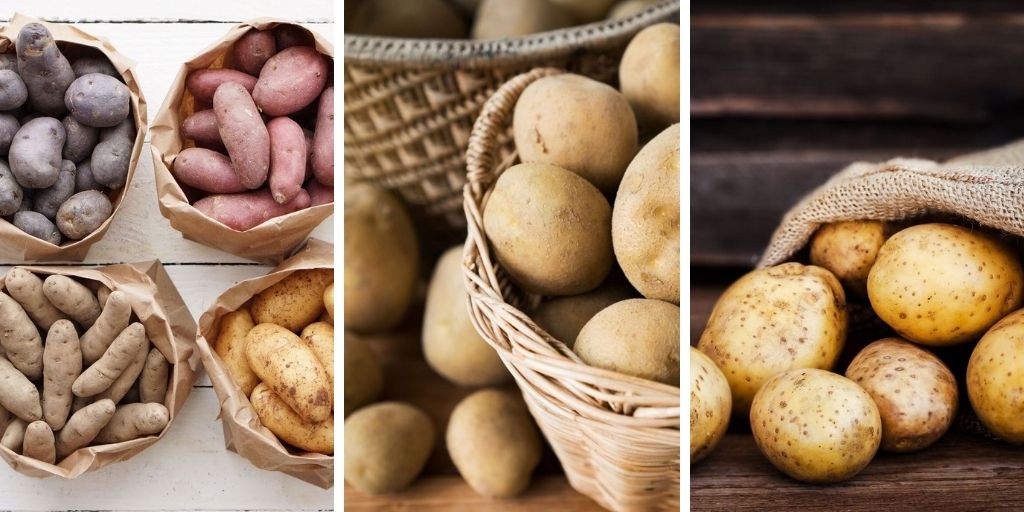There is no doubt that potatoes are the most popular veggie in the world. This vegetable constitutes the main human food. However, most people believe that they need gardens to grow this crop and enjoy it fresh. That is not entirely correct. Potatoes can be grown anywhere if the right conditions are met.
In fact, Potatoes are an easy vegetable to grow indoors and they can be grown continuously around the year. If you don’t have a garden and you’re a potatoes lover and you want to have your own crop, please follow this guide on how to potatoes indoors.
1. Choosing A Variety
Although most potatoes varieties can be grown indoors without any problem, there are some varieties that will give you a heavy crop. Below we selected the best varieties for you to choose from:
Petite Potato: The name suggests the type of these potatoes. They’re very small in size but very rich in potassium and vitamin C. It is also Cholesterol-free.

Purple/Blue Potatoes: These potatoes are usually grown in gardens but they can also be grown indoors without issues.

Fingerling: These Finger-like potatoes are cholesterol-free and rich in vitamin B6, fat, and sodium.

White Potato: Also known as all purpose potatoes. This variety produces light, white, thin, and smooth crop.

Russet: this is the most consumed potatoes varieties. It is large and very productive. Mostly, it is used for frying and baking.

Red Potato: It gets its name from its colour

2. Preparing the Seeds
Potatoes grow from seeds. The seed of the potato is any part that contains sprouts – also called eyes or chits. You can buy seeds from local nursery stores or you can make your own seeds by making potatoes sprout.
In order to transform a potato crop into a seed, you will need to leave it a dry, dark place for a couple of weeks until eyes start to sprout on the potato. Once you notice the eyes, cut the potato into two halves, pierce each half in a glass containing fresh water and leave for a week. Now, each half will have enough sprouts to grow on its own.
3. Choosing a container
These plants like moisture so a pot that helps the soil retain moisture is highly recommended. For this purpose, expert gardeners recommend terracotta or plastic pot. The pot should be at least 18 inches deep and 16 inches in diameter. Such a pot will be adequate for 4 plants.
Drainage holes are essential for any type of pot to avoid root rot. Therefore, you may want to use a tray at the bottom, so the water won’t leak to your house from the vessel. Talking about vessels, potatoes can also be planted in growing bags and even in polyethylene bags, dustbins, sacks, and tires. All require drainage holes.
4. Soil
If you’re buying a potting mix, get one that is light, loamy, and rich in organic matter. Potatoes are sensitive about the quality of soil and they do not do in well in wet and clay soil. For best results, you can try to make your own soil. All you need to do is to mix compost, peat moss, perlite and sand, and worm castings.
5. Planting
Potatoes need to be planted in a very particular way. First, make sure that the soil is moist. Second, place the sprouting half (the seed of the potatoes) on top of the soil with the eye buds (sprouts) facing the upward direction. Then lightly cover it with 5-6 inches of soil. Also, remember to leave a few inches between each potato seed you plant.
6. Location
When growing potatoes indoors, the best spot for them would be next to a window shell. These plants require at least 5 to 6 hours of daylight to grow. A balcony also would be a terrific choice. However, if you don’t have such a spot in your house, you may rely on grow light.

7. Watering
Potatoes love moist soil and it is the optimum growth condition for them. But they’re also prone to root rot. Therefore, you should water them frequently. Always keep the soil moist as these plants do not tolerate drought. However, do not drench and over water them as this may kill them too.
8. Caring For Potatoes
Caring for Potatoes includes fertilizing and watching out from pests and diseases. These healthy veggies are considered heavy feeders. Applying well-rotted manure or compost is highly recommended.
As per pests and diseases, you need to keep an eye on Potato beetles, flea beetles, and aphids. Applying an organic fertilizer that does not contain much Nitrogen will help you against these pests.
9. Harvesting
When the leaves turn yellow and the bloom appears, this means that your veggie is ready for harvest. You can start picking the crop. If you wash it, you will need to shortly consume it. If you’re planning on storing them, wash them dry and let them in a cool place for a week then store them.
Hope this article guides you into planting a productive and healthy crop of potatoes and if you have any questions for us, please leave them below

